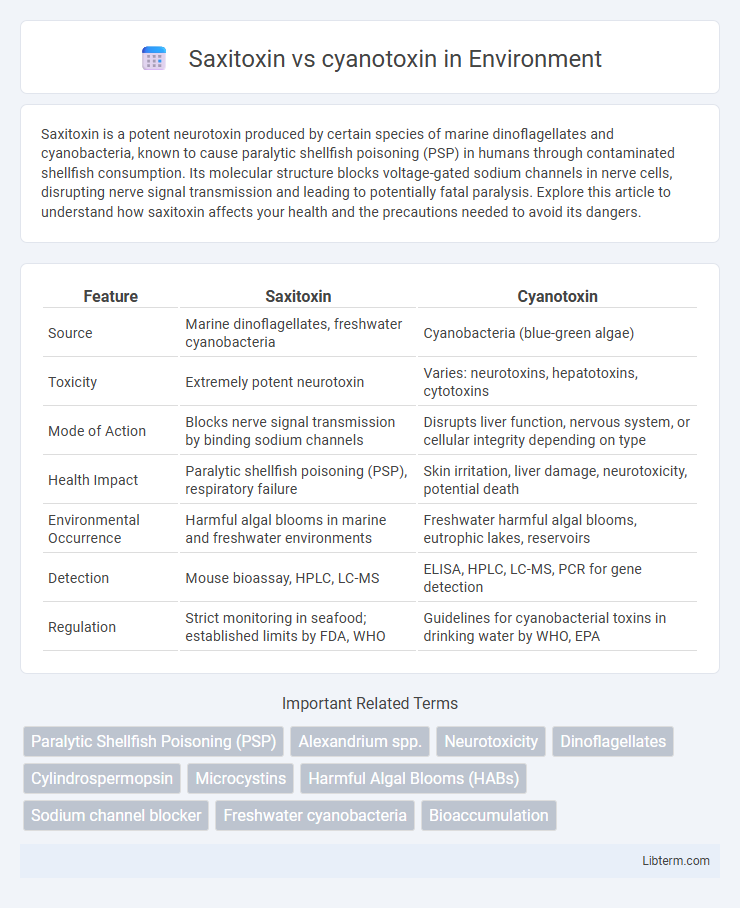Saxitoxin is a potent neurotoxin produced by certain species of marine dinoflagellates and cyanobacteria, known to cause paralytic shellfish poisoning (PSP) in humans through contaminated shellfish consumption. Its molecular structure blocks voltage-gated sodium channels in nerve cells, disrupting nerve signal transmission and leading to potentially fatal paralysis. Explore this article to understand how saxitoxin affects your health and the precautions needed to avoid its dangers.
Table of Comparison
| Feature | Saxitoxin | Cyanotoxin |
|---|---|---|
| Source | Marine dinoflagellates, freshwater cyanobacteria | Cyanobacteria (blue-green algae) |
| Toxicity | Extremely potent neurotoxin | Varies: neurotoxins, hepatotoxins, cytotoxins |
| Mode of Action | Blocks nerve signal transmission by binding sodium channels | Disrupts liver function, nervous system, or cellular integrity depending on type |
| Health Impact | Paralytic shellfish poisoning (PSP), respiratory failure | Skin irritation, liver damage, neurotoxicity, potential death |
| Environmental Occurrence | Harmful algal blooms in marine and freshwater environments | Freshwater harmful algal blooms, eutrophic lakes, reservoirs |
| Detection | Mouse bioassay, HPLC, LC-MS | ELISA, HPLC, LC-MS, PCR for gene detection |
| Regulation | Strict monitoring in seafood; established limits by FDA, WHO | Guidelines for cyanobacterial toxins in drinking water by WHO, EPA |
Understanding Saxitoxin and Cyanotoxin: Key Differences
Saxitoxin is a potent neurotoxin produced primarily by marine dinoflagellates, responsible for paralytic shellfish poisoning, while cyanotoxins are diverse toxins produced by freshwater cyanobacteria with varying effects on liver, nervous system, or skin. Saxitoxin specifically blocks sodium channels in nerve cells, causing paralysis, whereas cyanotoxins include microcystins, anatoxins, and cylindrospermopsin, each targeting different biological systems. Monitoring environmental conditions such as algal blooms is essential for managing risks associated with these toxins in aquatic ecosystems.
Chemical Structures and Origins
Saxitoxin, a potent neurotoxin, features a complex bicyclic guanidinium moiety responsible for its sodium channel blocking activity and is primarily produced by marine dinoflagellates such as Alexandrium species. Cyanotoxins encompass a diverse group of chemical structures, including microcystins with cyclic heptapeptides and cylindrospermopsin, an alkaloid, originating from cyanobacteria like Microcystis and Cylindrospermopsis. The structural diversity of saxitoxin and cyanotoxins correlates with their distinct biosynthetic pathways and ecological origins, influencing their toxicity mechanisms and environmental distribution.
Sources and Occurrence in Nature
Saxitoxin is primarily produced by marine dinoflagellates such as Alexandrium, causing paralytic shellfish poisoning in coastal waters worldwide. Cyanotoxins, including microcystins and cylindrospermopsin, are synthesized by freshwater cyanobacteria like Microcystis and Cylindrospermopsis, frequently occurring in lakes and reservoirs during harmful algal blooms. Both toxins emerge from different microorganisms in distinct aquatic environments, with saxitoxin linked to marine systems and cyanotoxins to freshwater ecosystems.
Mechanisms of Toxicity
Saxitoxin exerts its toxicity by blocking voltage-gated sodium channels in nerve cells, preventing nerve impulse transmission and causing paralysis. Cyanotoxins, such as microcystins, primarily inhibit protein phosphatases 1 and 2A, leading to cellular disruption and liver damage. Both toxins disrupt essential biological functions but target different molecular pathways, resulting in distinct toxicological effects.
Symptoms of Toxicity in Humans
Saxitoxin exposure causes paralytic shellfish poisoning characterized by numbness, tingling, and muscle paralysis that can lead to respiratory failure. Cyanotoxins, produced by cyanobacteria, induce symptoms such as liver damage, neurotoxicity, skin irritation, and gastrointestinal distress depending on the toxin type like microcystins or anatoxins. Both toxins pose significant health risks through contaminated water or seafood, necessitating monitoring to prevent human toxicity.
Detection and Monitoring Methods
Saxitoxin detection primarily relies on high-performance liquid chromatography (HPLC) coupled with fluorescence or mass spectrometry for precise quantification, enabling monitoring in shellfish and algal blooms. Cyanotoxins are commonly detected using enzyme-linked immunosorbent assays (ELISA), liquid chromatography-mass spectrometry (LC-MS), and molecular techniques targeting toxin synthesis genes in cyanobacteria. Continuous environmental monitoring integrates remote sensing and in situ biosensors to provide early warnings and assess toxin distribution in water bodies.
Environmental and Health Impacts
Saxitoxin, a potent neurotoxin produced by marine dinoflagellates, causes paralytic shellfish poisoning and poses severe risks to marine ecosystems and human health through contaminated seafood consumption. Cyanotoxins, produced by freshwater cyanobacteria during harmful algal blooms, lead to water quality degradation, fish kills, and exposure risks such as liver damage and neurotoxicity in humans and animals. Both toxins disrupt aquatic food webs and threaten public health by contaminating water sources and seafood with neurotoxic and hepatotoxic effects.
Regulatory Guidelines and Safety Limits
Saxitoxin, a potent neurotoxin produced by certain marine dinoflagellates, is regulated under strict limits with the US FDA setting a maximum allowable concentration of 80 micrograms per 100 grams of shellfish tissue to prevent paralytic shellfish poisoning. Cyanotoxins, produced by freshwater cyanobacteria, have varying safety guidelines depending on the toxin type; the World Health Organization recommends a provisional guideline of 1 microgram per liter for microcystin-LR in drinking water. Regulatory agencies emphasize routine monitoring and risk assessment to enforce these safety limits and protect public health from toxin exposure in seafood and water supplies.
Prevention and Treatment Strategies
Prevention of saxitoxin poisoning involves monitoring and managing harmful algal blooms, particularly those caused by toxic dinoflagellates, while cyanotoxin exposure is reduced by controlling cyanobacterial growth in freshwater systems through nutrient management and water treatment. Treatment for saxitoxin poisoning is primarily supportive, focusing on respiratory support and symptomatic care due to its potent neurotoxicity, whereas cyanotoxin poisoning treatment often requires decontamination, activated charcoal administration, and addressing liver or neurological damage depending on the toxin type. Both toxins necessitate early detection through advanced monitoring technologies and prompt medical intervention to mitigate severe health outcomes.
Future Research and Emerging Concerns
Future research on saxitoxin and cyanotoxins emphasizes advanced detection methods and mitigation strategies to address rising incidences linked to climate change and harmful algal blooms. Emerging concerns include the potential bioaccumulation of saxitoxins in seafood and the increasing diversity of cyanotoxin-producing cyanobacteria strains. Understanding molecular pathways and environmental triggers remains critical for developing targeted interventions and protecting public health.
Saxitoxin Infographic

 libterm.com
libterm.com